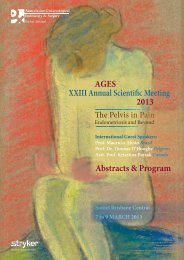to Obstetric Trauma Pelvic Floor Repair Surgical Essentials - AGES
to Obstetric Trauma Pelvic Floor Repair Surgical Essentials - AGES
to Obstetric Trauma Pelvic Floor Repair Surgical Essentials - AGES
You also want an ePaper? Increase the reach of your titles
YUMPU automatically turns print PDFs into web optimized ePapers that Google loves.
Free<br />
Communications<br />
Session 7B 7A<br />
Saturday<br />
4 June<br />
Session 7 - Free Communications A<br />
1350-1400<br />
Laparoscopic mesh sacrocolpopexy:<br />
6-year outcomes at CARE, Sydney<br />
Patel PS, Dunkley EJC, Lam A<br />
OBJECTIVE: To evaluate the outcomes of laparoscopic mesh<br />
sacrocolpopexy (LSC) for Level I prolapse.<br />
METHODS: A prospective analysis was conducted on all patients<br />
undergoing LSC using Gynemesh ® by a single surgeon at a tertiary<br />
referral centre between November 2004 and December 2010.<br />
Cure was evaluated subjectively based on patients’ answers <strong>to</strong><br />
standardised questions regarding bowel, bladder and sexual<br />
function, and objectively by pelvic exam findings at pre- and pos<strong>to</strong>perative<br />
visits using the pelvic organ prolapse quantification<br />
(POP-Q) scale. Pos<strong>to</strong>perative follow-up included routine visits at 6<br />
weeks and 12 months, as well as any unscheduled visits.<br />
RESULTS: A <strong>to</strong>tal of 164 patients, at a mean age of 63 ± 10 years,<br />
underwent LSC. Eighty two percent had POP-Q Stage ≥3, and 66%<br />
had recurrent prolapse.<br />
Thirty seven patients (23%) underwent laparoscopic hysterec<strong>to</strong>my<br />
at the time of LSC; 108 (66%) had concurrent Level II/III repairs.<br />
The average overall operative time and estimated blood loss<br />
were 115 min and 77 mL respectively. The only intra-operative<br />
complications consisted of 2 cases of bleeding during paravaginal<br />
dissection, and neither patient required a transfusion. Major<br />
post-operative complications included 1 case of bleeding due <strong>to</strong><br />
anticoagulant use, requiring 3 units of blood transfusion, 1 transient<br />
ischemic attack, 1 new onset atrial fibrillation, and 1 case of deep<br />
vein thrombosis.<br />
Two patients were lost <strong>to</strong> follow-up; the remaining 162 patients were<br />
followed for an average of 11 months. The objective cure rate of LSC,<br />
defined as an apical POP-Q stage of ≤1, was 98%. The 3 procedural<br />
failures were first diagnosed at an average of 9 months, and only<br />
one patient needed re-operation. All 44 patients who had previously<br />
failed a Level I repair had successful outcome after their LSC. Of<br />
the patients who had Level II Stage ≥2 defects who did not undergo<br />
concurrent site-specific repairs, 92% were cured by LSC alone.<br />
Subjectively, cure was noted in 94% of patients with general<br />
prolapse symp<strong>to</strong>ms, 83% with obstructive bladder symp<strong>to</strong>ms, 60%<br />
with bowel symp<strong>to</strong>ms, and 89% of patients with sexual symp<strong>to</strong>ms.<br />
Eight patients (6%) developed occult stress incontinence, and 5<br />
(4%) experienced de novo dyspareunia. Nine (6%) mesh erosions<br />
occurred, at an average of 23 months after surgery. There was a<br />
non-significant trend <strong>to</strong>wards higher mesh erosion in patients who<br />
underwent concurrent hysterec<strong>to</strong>my (11% vs 4%, P=0.212).<br />
CONCLUSIONS: LSC is an effective, minimally invasive option for<br />
apical vaginal prolapse.<br />
AUTHOR AFFILIATION: P. S. Patel, E. J. C. Dunkley, A. Lam; Centre<br />
for Advanced Reproductive Endosurgery (CARE), St Leonards, NSW,<br />
Australia.<br />
Session 7 - Free Communications A<br />
1400-1410<br />
Six-year review of pelvic floor<br />
repairs in an established<br />
Endogynaecological Unit: the<br />
emergence of the laparoscopic<br />
sacrocolpopexy<br />
Fleming T, Cario G, Chou G, Rosen D, Cooper M, Reid G, Aust T,<br />
Reyftmann L<br />
In the age of evidence based medicine, surgical management of<br />
common conditions must evolve accordingly. Following publication<br />
of the Cochrane Systematic Review in April 2010 (Maher et al), the<br />
laparoscopic sacrocolpopexy (LSCP) has become the gold standard<br />
of surgical treatment for pelvic organ prolapse.<br />
The pelvic floor data from a multicentre gynaecological endoscopic<br />
unit have been retrospectively reviewed <strong>to</strong> assess the distribution of<br />
prolapse procedures undertaken and the incidence of complications<br />
associated with these procedures. The practice consists of five<br />
advanced laparoscopic surgeons and cumulative data encompasses<br />
greater than 1500 cases of surgical management of pelvic floor<br />
deficiencies. <strong>Pelvic</strong> floor repair is a primary component of surgical<br />
activity for this unit, representing 19% of <strong>to</strong>tal workload.<br />
The most outstanding feature of this data is the evolution of surgical<br />
preferences from laparoscopic anterior and posterior pelvic floor<br />
repairs, <strong>to</strong> the preponderance of LSCP. In the five year period from<br />
2005 <strong>to</strong> 2009, LSCP represented only 14% of surgical management<br />
for prolapse. This is in stark contrast <strong>to</strong> the 2010 data, where LSCP<br />
was the preferred surgical approach in 60% of pelvic floor operations.<br />
With any new surgical technique, there is a learning curve during the<br />
acquisition of the skill. LSCP is a particularly complicated procedure,<br />
and the effect of the learning curve was evident even within this<br />
experienced group of laparoscopic surgeons. This was reflected on<br />
17

















